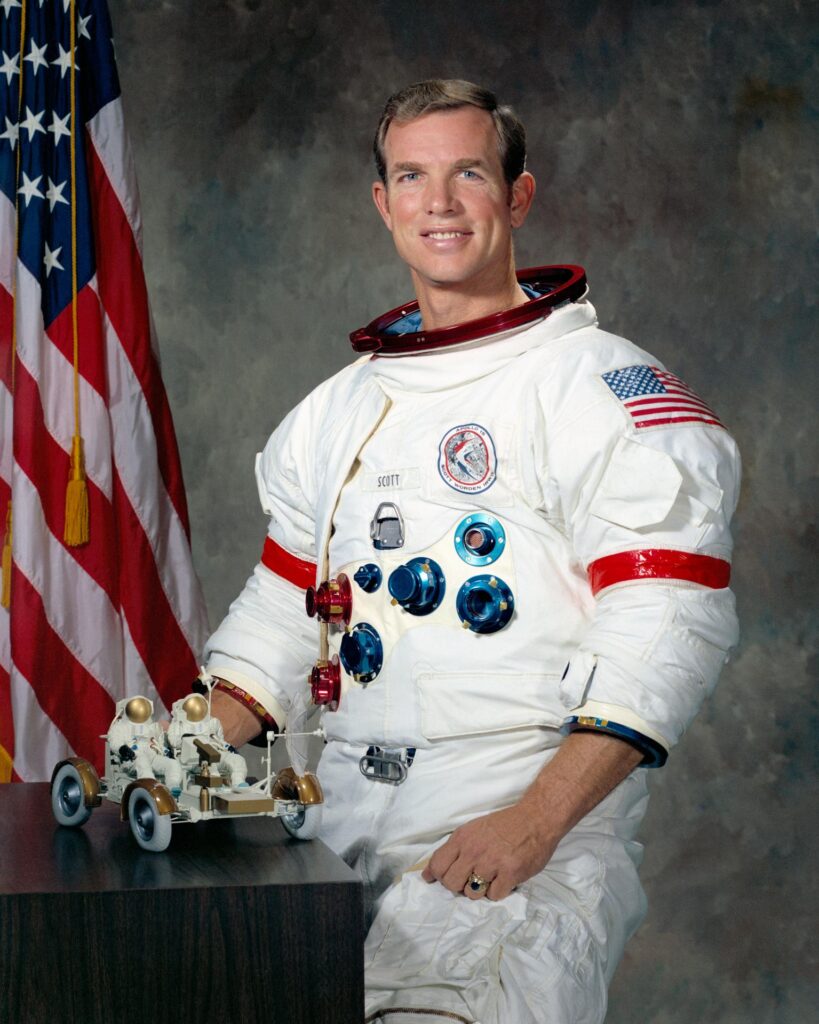Commander of the Apollo 15 lunar landing mission, it was the first to use a lunar rover.
David R. Scott flew on Gemini VIII, was Command Module pilot on Apollo 9, and drove the first Lunar Rover on the moon as Commander of Apollo 15.
Scott was born on June 6, 1932, in San Antonio, Texas. He graduated from Western High School in Washington, D.C., and in 1954 received a Bachelor of Science degree from the U.S. Military Academy, standing fifth in a class of 633. He then entered the Air Force and later graduated from the Experimental Test Pilot School and Aerospace Research Pilot School at Edwards Air Force Base, California. In 1962, Scott received a Master of Science degree in Aeronautics/Astronautics Engineering from the Massachusetts Institute of Technology.
NASA selected David Scott as an astronaut in 1963. On March 16, 1966, Pilot David Scott and Commander pilot Neil Armstrong entered space aboard Gemini VIII. Their primary mission was to conduct the first linkup in space by docking their capsule with an Agena target satellite. Shortly after the successful docking, however, the conjoined crafts began spinning out of control. Armstrong disengaged the capsule. NASA later determined that one of sixteen Gemini thrusters had become stuck in the open position, emptying fuel into space. Unable to stop the spin with the main thrusters, the crew were finally able to stabilize the capsule after thirty minutes by using engines intended for re-entry. A planned extravehicular activity (EVA) by Scott was canceled and the mission was ended early. After a flight of ten hours and 41 minutes, Gemini VIII splashed down safely in the Pacific Ocean.
Scott next entered space as the Command Module pilot for Apollo 9. This successful ten-day Earth orbit flight was launched on March 3, 1969, and was the first test of a complete set of Apollo hardware, including the Lunar Module (LM). Scott was accompanied by Mission Commander James A. McDivitt and Lunar Module pilot Russell L. Schweickart, McDivitt and Schweickart separated the LM and flew 113 miles away from Scott and the mother ship before flying back to a rendezvous and linkup of the two capsules.
Scott’s third space mission, Apollo 15 was launched on July 26, 1971. Four days later the LM Falcon with Mission Commander Scott and Lunar Module pilot James B. Irwin landed on the Moon in a narrow valley, hemmed in on three sides by the 15,000-foot-tall Apennine Mountains, and on the fourth by a mile-wide canyon named Hadley Rille. They explored the lunar surface while Alfred M. Worden orbited in the Command Module Endeavor. This was the first extended scientific expedition to the moon and the first use of the Lunar Rover, a specially designed electric car. In three excursions during their three-day stay on the moon, Scott and Irwin drove over seventeen miles, gathered 171 pounds of lunar samples, set up a science station and took many photographs.
The major scientific objectives of the Apollo 15 mission were to conduct extensive geological exploration, comprehensive geologic sampling, and photographic documentation of the Apennine Front at Hadley Delta, Hadley Rille, and the mare plain; to emplace the Apollo lunar surface experiments package (ALSEP) near the landing site; and to perform a series of survey experiments with the scientific instrument module equipment from lunar orbit and during trans-Earth coast.
Because of the extended capability of the life-support equipment and the new mobility provided by the lunar roving vehicle, the Apollo 15 astronauts explored a much larger area than had been possible on previous missions, meeting all of the mission’s goals. Extensive information also was obtained about the secondary crater cluster near the Hadley Delta scarp and, although not visited, about the North Complex. The Falcon lifted off the moon and rendezvoused with Worden on August 2, and Apollo 15 ended with a safe splashdown in the Atlantic Ocean on August 8, 1971.
During his three flights, David Scott logged 546 hours and 54 minutes in space, of which twenty hours and 46 minutes were in EVAs. He is only one of three Astronauts who has flown both earth orbital and lunar Apollo Missions. In July 1972, he became Special Assistant for Mission Operations for the Apollo-Soyuz Test Project, and in April 1975, was appointed the director of the NASA Dryden Flight Research Center. Colonel David Scott retired from the Air Force in March 1975 after logging over 5600 hours of flying time.
Colonel Scott left NASA on October 30, 1977. During his career, he earned two NASA Distinguished Service Medals, the NASA Exceptional Service Medal, two Air Force Distinguished Service Medals, the Air Force Distinguished Flying Cross, the Air Force Association’s David C. Schilling Trophy and the Robert J. Collier Trophy for 1971.
In 2004 David Scott wrote a book along with Alexei Leonov, the first man to walk in space, entitled Two Sides of the Moon, about being on opposing sides of the space race during the Cold War. Colonel Scott is currently president of Scott Science and Technology, Inc. He resides in Manhattan Beach, California.

